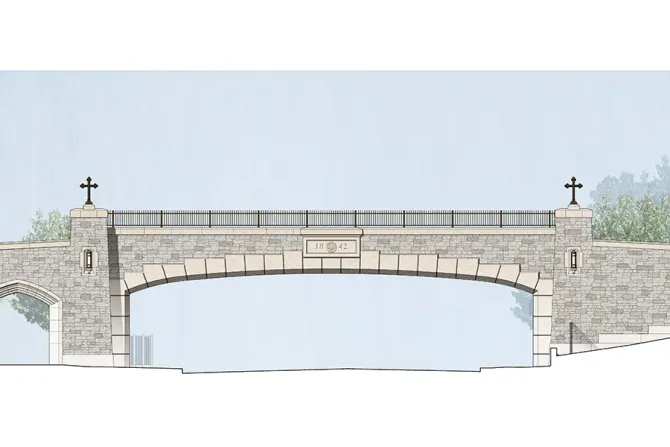Philadelphia, Pa., Mar 22, 2017 / 14:40 pm
A bridge featuring crosses on the property of Villanova, a Catholic university in a Philadelphia suburb, will be built despite complaints from some local taxpayers.
After an hour long debate, the Board of Commissioners of the township of Radnor voted 6-0 last month to approve the controversial pedestrian bridge that will connect Villanova University's main campus with an expansion of the campus.
The crux of the debate was the two, 4-foot 7-inch crosses planned for the top of the bridge, which will be visible to travelers on Route 30 underneath. Some local taxpayers complained that the school was crossing the line of separation of church and state by placing the crosses over a public road.
"I think they are overstepping their sense of ecumenism to shove these crosses in our faces," Sara Pilling, a longtime resident and opponent of the crosses, told The Inquirer Daily News before the meeting.
Others argued that taxpayer dollars should not fund a bridge that will feature displays of religion.
Villanova officials argued that the school was within its rights to place crosses on the bridge, which will be owned by the university and on university property.
"On every building on campus, there's a cross," Fr. Peter Donohue, university president, told the Inquirer.
"I understand people's sensitivities, but it's just something we've always done. It's just part of who we are. We are a faith-based institution."
Some locals believe that a compromise would be to turn the crosses so they face the pedestrians, or to incorporate them into the design of the bridge in a more subtle way.
"While we recognize the importance of Villanova to our community and the notoriety it brings to Radnor, are there less ostentatious ways to reflect a Catholic institution?" said Roberta Winters, president of the League of Women Voters of Radnor, in an interview with The Inquirer.
Commissioner Luke Clark told local media that the bridge has been in the works for a long time, and is a way to keep safe the hundreds of students who cross that road every day.
"The design looks great. The crosses are going to go up there. Is it right or wrong? I don't know. But at the end of the day it is on their property. They are a religious institution and the law for the most part is in their favor," said Clark.
Even after the board unanimously voted to approve the bridge, some concerned locals contacted the non-profit Freedom From Religion Foundation. The foundation wrote a "strongly worded letter" to the Pennsylvania Department of Transportation (PennDOT), contending that they were unconstitutionally funding Christian symbols on the bridge and asked them to removed either the crosses or their funding.
The department told local media that its $3.7 million contribution to the project was for the portion of the span over the right of way it controls.
PennDOT said it could not control what the university did with its own property and with its own funds, which are providing for the crosses and most of the bridge.
After the township vote Villanova's assistant vice president of government relations and external affairs Chris Kovolski told The Inquirer: "We're pleased that the conversation tonight resulted in an outcome that allows the university to move forward."
(Story continues below)



